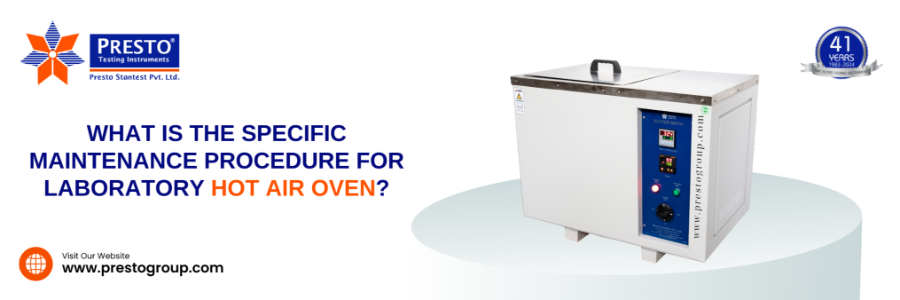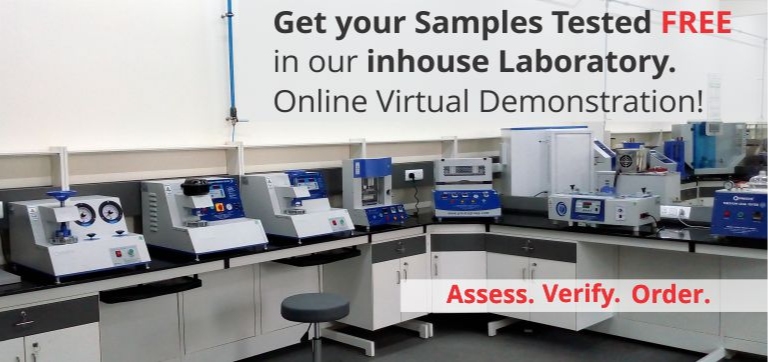What is the Specific Maintenance Procedure for Laboratory Hot Air Ovens?

Gaurav Malhotra
Sterilizing and maintaining temperatures for certain samples is paramount in delivering accurate products. Thus, with Presto laboratory hot air oven manufacturers can easily detect the change in the physical characteristics of the materials and ascertain the actual working life at elevated temperatures. Operates on the principle of forced air circulation through thermal convection, the system is well-suited for conducting tests crucial in the rubber and plastic industries, including heat deformation, compression set, and heat resistance evaluations.
In this blog, we will delve into some important steps of the maintenance protocols tailored for laboratory hot air ovens, shedding light on the essential tips to preserve their efficiency. Additionally, we will explore how Presto Laboratory hot air oven proves instrumental in the precise sterilization of samples, contributing to the integrity of experimental outcomes. The incorporation of advanced technology in Presto Lab's hot air oven enhances its capacity to deliver accurate and consistent sterilization, making it an essential laboratory testing instrument in different industries.
Importance of Regular Maintenance of Laboratory Hot Air Ovens
Maintaining the hot air oven is important to ensure its optimal performance and reliability. Thus, with Presto lab hot air oven, manufacturers can easily and accurately get precise lab testing results. Below we have listed some points that indicate the importance of maintaining the lab hot air oven accurately.
Precise and accurate test results: Consistent maintenance of laboratory hot air oven is crucial for preserving the accuracy and precision of temperature control in a hot air oven. This is especially vital for experiments and tests that require precise temperature conditions, guaranteeing dependable and uniform results.
Ensuring longevity of hot air oven: Effective maintenance increases the lifespan of the laboratory hot air oven. Maintaining the hot air oven effectively helps to increase the longevity of the equipment and reduce costly repairs.
Safety Assurance: Conducting regular inspections and adhering to maintenance routines play a vital role in fortifying the safety of the laboratory environment. This is especially critical when handling heat-sensitive materials, as a properly maintained oven is less prone to presenting safety risks like overheating or malfunctions.
Consistent test performance: Engaging in maintenance tasks such as regular cleaning and calibration is instrumental in sustaining the consistent performance of the hot air oven. This is indispensable for establishing reproducible experimental conditions and ensuring the reliability of data in scientific research. You can read more on the use of laboratory hot air ovens in the microbiology industry.
Compliance with industrial standards: Consistent maintenance guarantees that the laboratory hot air oven remains compliant with industry and safety standards. It is important for the testing labs to operate this environmental chamber in regulated environments.
These are some points that indicate maintaining a lab hot air oven is a best practice and necessity for ensuring the safety of a hot air oven.
Advantages of Using Hot Air Oven
Using a hot air oven for sterilization presents several advantages, making it an effective and reliable testing instrument:
Sterilization of products:
The hot air oven simplifies and streamlines the sterilization process, making it effortlessly efficient. Its well-thought-out design and functionality contribute to the ease of use, ensuring that sterilizing products is not only effective but also a convenient task. You can read more on what can be sterilized in a hot air oven so that you will get highly accurate lab testing results.
Prevention of Corrosion and Rust:
The dry heat generated by the hot air oven is carefully controlled to eliminate the risk of corrosion or rust on tools and needles. This protective environment ensures the longevity and functionality of the sterilized instruments.
Robust and Non-Dismantling Components:
The hot air oven employs multiple components to generate dry heat, and these components are designed to withstand the sterilization process without dismantling. This robust construction enhances the reliability and longevity of the testing instrument.
Safe for Metals and Glass Equipment Testing:
A notable benefit of the hot air oven lies in its non-detrimental impact on metals and other glass equipment. This quality renders it a versatile instrument for sterilizing a diverse range of materials, ensuring the process is conducted without causing harm or deterioration to the items being treated.
These are some of the advantages of using a hot air oven. You can also read more on the hot air oven working principle so that it will be easy for you to operate this testing equipment.
Now, let us discuss brief information about the procedure to maintain the hot air oven.
Easy Procedure to Maintain the Hot Air Oven Effectively
For hot air oven maintenance, you can read the following points mentioned below:
Maximum Heating Capacity and Operation Timer:
Adhere to the specified maximum heating capacity and operation timer. Exceeding these limits can lead to potential damage to the hot air oven or compromise the accuracy of the results. Following the recommended parameters ensures safe and effective operation.
Close the chamber door properly:
Always ensure that the chamber doors are securely closed during the operation of the hot air oven. Proper closure helps maintain the desired temperature inside the chamber, prevents heat loss, and ensures the efficiency of the sterilization or testing process.
Clearance from Walls:
Allow at least one foot of clearance between the hot air oven and surrounding walls. This clearance ensures proper ventilation and prevents any potential interference with the oven's exhaust or cooling systems. It also minimizes the risk of heat buildup in the immediate vicinity.
Avoid liquid sample testing:
Never place liquid materials inside the heating chamber. This is because the Presto Group hot air oven has been specifically designed for dry heat applications. If you will put the liquid materials in the humidity chamber then it will compromise the integrity of the equipment.
By following these maintenance guidelines helps ensure the safe, effective, and reliable operation of the hot air oven, extending its lifespan and maintaining the quality of experimental or sterilization processes. Contact us at +919210903903 or email us at info@prestogroup.com
to know more about this testing equipment.
you may also like
- The Ultimate Guide to Lab Testing Equipment: Ensuring Quality with Precision Instruments
- GSM Calculator Guide: How to Measure Fabric, Paper & Plastic Weight
- What Is a Gloss Meter? Working Principle, Uses & Benefits Explained
- Applications of Tensile Testers in Plastic, Metal & Rubber Industries
- How UV Chambers Help Manufacturers Beat Sunlight and Weather Challenges
Recent News
- Paper & Packaging Testing Instruments
- Paint, Plating & Coating Testing Instruments
- Plastic & Polymer Testing Instruments
- Environmental Testing Chambers
- PET & Preform Testing Instruments
- Color Measuring Testing Instruments
- View Entire Range Instruments

Catalogue 2023
Get information about new product launches, research, innovation and endeavors at Presto.
download Free Copy
Get a Quote

